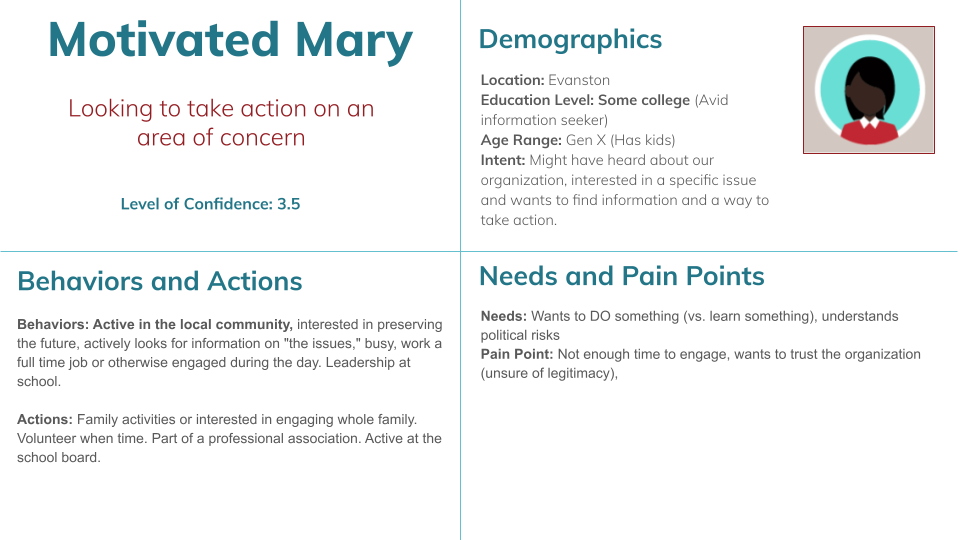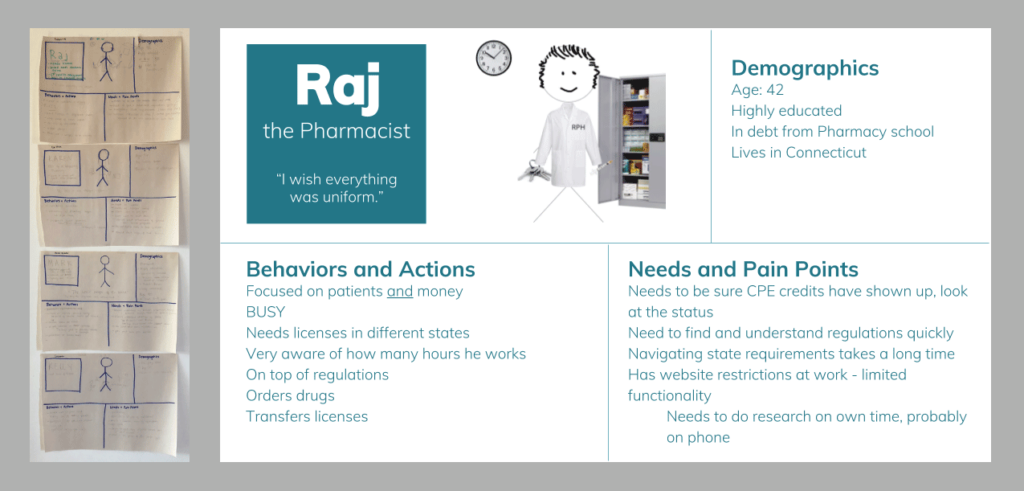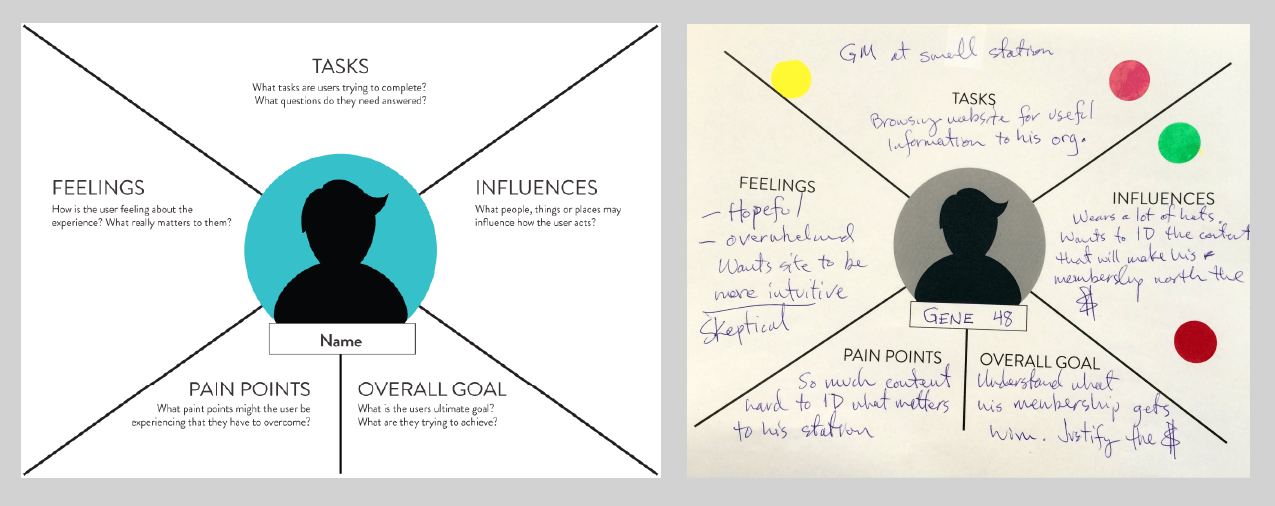How to Create More Inclusive User Personas

Marketing and user personas are helpful research tools, but they’re not perfect. In this post, we explore where personas shine, why they sometimes fail, and ways to use them more inclusively and effectively without blowing your budget.
If you’re creating a new product, solving the right problems for the right people is important. By focusing on specific customer problems, you can create something that is useful and desirable.
Personas focus your product development efforts on customer needs. However, they can also lead to problems. Let’s explore how.
Types of Personas
Personas are fictionalized characterizations meant to help marketing, design, and product teams better understand how different stakeholders might interact with your product or service.
Personas typically describe a target customer’s desires, goals, behaviors, or limitations. They also include generalized customer traits, such as:
- Demographic information
- Pain points
- Values
- Goals
- Personal preferences
- Employment
- Potential objections
- and so on…
Personas align product stakeholders on who they want to reach and what is most important to those people. These can positively contribute to sustainable web design and accessibility practices by allowing organizations to efficiently tailor their digital products or services to specific users.
Finally, persona exercises add value to discovery workshops, product roadmapping sessions, stakeholder mapping, or as part of your content strategy or a content mapping workshop.
Personas come in several flavors. For example, marketing and user personas serve different purposes.
Marketing Personas
Marketing personas, also called buyer profiles or customer personas, focus on buyer habits, distribution channels, and demographics. They exist to identify market segments and specific buyers within those segments.
Marketing personas may include a customer’s ability to purchase a product or details about their personal life specific to product or company interactions.
User Personas
If marketing personas define who your customer is, user personas define how they engage with your brand online. Design leader Alan Cooper is credited with creating user personas back in the 1980s.
On digital projects, personas create empathy for users. These personas explore people’s psychology and behavioral patterns when interacting with digital products and services. For instance, demographic information is more useful when it directly relates to improving usability than in the marketing persona scenario described above.

The Problem with Personas
Most of us learned to think about personas as a tool to represent what we learned in our research. And it was often the case that we created personas as the output of lengthy, expensive research studies. There are a few problems with personas that are created this way. First, we tend to regard them as untouchable because of all of the work that went into creating them. In addition, it’s often the case that these personas were created by a research team or third-party vendor. This creates a risky knowledge gap between the people who conducted the research and those who are using the personas.
— Jeff Gothelf and Josh Seiden, Lean UX: Designing Great Products with Agile Teams
Personas receive criticism for numerous reasons, the most common being:
- Because they are fictional and created early in a product life cycle, clear relationships between aspirational traits outlined in personas and what real users actually want don’t exist.
- They are often created by third parties as part of extensive and costly studies, so teams might hesitate to question their assumptions.
- Personas justify poor product decisions that actually distance the very customers they espouse to personify.

Confirmation Bias in Personas
Personas are misused to maintain a ‘safe’ distance from the people we design for, manifesting contempt over understanding, and creating the facade of user-centeredness while merely reinforcing who we want to be designing for and selling to.
— Steve Portigal, Persona Non Grata
In his paper referenced above, Steve Portigal outlines how a client described various persona types in “infantilizing” ways, such as using cartoony names like Critical Incident Carl or Integrator Ian.
Steve also notes that the “ease with which she spoke to us about real people as if they were characters from the Strawberry Shortcake universe was distressing”—which is just an amazing way to describe this disconnect.
It is easy to see how inefficient traditional personas are at helping product stakeholders think about potential customers as real people. They enable teams to justify creating features based on aspirational caricatures and manufactured details without validating whether actual humans care about those features and want to use them.
Similarly, personas are sometimes cited as “data” to confirm biases product teams already have about potential users. If persona characteristics are based on assumptions, not scientific evidence, this can be a dangerous—and potentially expensive—game.
With all this said, is it viable to use personas when creating digital products and services? Yes, but we should rethink how to use them.
Going Lean with Proto Personas
Proto personas, also known as lean personas, are based on assumptions rather than hard research and serve several purposes:
- Proto personas jump-start the research process by quickly building consensus as part of a workshop.
- Good proto personas can also help you quickly align business goals with user needs.
- They foster important discussions with project stakeholders throughout the entire product development life cycle.
Proto personas have two important distinctions from their more traditional counterparts:
- They are created after you make assumptions about what users want, not before.
- The learning process is ongoing.
Let’s explore what this means in a bit more detail.
Assumptions Before Personas
Researchers can spend weeks or even months in the field collecting data for traditional personas. In contrast, proto personas are completed during a short workshop session. You understand project requirements and users first, then move on to research that validates (or refute) assumptions.
With more traditional methods, it’s the other way around. As such, proto personas can serve as a helpful precursor to conducting user interviews or in other forms of user research and testing.
Level of Confidence
Also, assigning a level of confidence to your proto-persona helps teams figure out how much more user research and testing or rapid prototyping is needed. In our workshops, we assign a number from one—indicating a low level of confidence—to five for each persona. If the level of confidence is low on any persona, we recommend doing more research to boost it.
This process helps stakeholders better understand whether or not a product idea might resonate with target users. However, it is critical that your team is honest in assessing user needs. Otherwise, this could be a futile exercise.
Creating More Inclusive User Personas with Permutations
Next, because personas are typically created without representation, they often fall into the “one-size-fits-all” trap, which is problematic.
To address this, create permutations that alter a specific trait or demographic. After adding a persona permutation, how will this change apply to the product or service you hope to create? What else might you need to consider?
- Remove gender-specific names and pronouns. Does it still hold up?
- Consider impairments and disabilities. What must change if your persona subject is deaf, blind, neurodiverse, in a wheelchair, needs glasses, or has a broken arm?
- How might race, cultural background, religious affiliation, sexual orientation, or other criteria impact a persona subject’s behavior?
- Will a life change, like moving to a new location, having a child, losing a job, or getting divorced, impact a persona subject’s behavior? If so, how?
Poke holes in your proto persona to see how it stands up under different circumstances. Ideally, you should do this during a workshop as well as throughout a project. If you need to better understand your organizational ecosystem, consider running a stakeholder mapping workshop prior to your persona workshop.
Most importantly, after the exercise is complete, validate or refute permutations with additional research and user interviews.
Also, for a more detailed breakdown of how to use persona permutations, read Sophie Shrimpton’s Medium post, Your one size fits all persona doesn’t work and what to do about it.
Proto Personas and Continuous Learning
Finally, during UX Design practices, such as wireframing and prototyping, product teams will validate or refute assumptions made about customers and re-prioritize based on what they learned from those tactics.
Teams should adjust proto personas accordingly over time so they always reflect the latest insights. More importantly, this helps stakeholders maintain consensus and better target customer needs as the product or service continues to evolve.

Running a Lean User Persona Workshop
Let’s look at how proto persona exercises bring value to a workshop.
For this exercise, you will focus on just a single user type. You can repeat the process as many times as necessary, but the point is to collect enough information to build consensus within the group about that user type.
This forms a baseline to discuss desired outcomes and, eventually, a hypothesis about the features you might build to meet their needs. Eventually, you will validate this hypothesis with further testing and research.
Proto Persona Workshop Steps
First, get your key stakeholders—product managers, marketers, UX designers, content strategists, clients, etc.—in a room or in front of a virtual whiteboard. If at all possible, include one or several people who represent those you hope to reach. This will make a big difference in workshop outcomes.
If your workshop is held in-person, give everyone a template (see below) to complete. If you’re running this exercise using a virtual collaboration tool, discuss details about a specific user as a group:
Goals
- What problem are they trying to solve?
- Why might they use your product or service?
- What is their desired outcome?
Tasks
- How might they interact with a product or service?
- What tasks do they need to complete?
- How much time do they have to complete these tasks?
- What if they stop halfway through?
Feelings
- What is on their mind before and during use?
- Are they frustrated? Angry? Delighted?
Influences
- What is going on behind the scenes?
- Are they shopping? At a library? Juggling childcare?
Pain Points
- What obstacles keep them from achieving their goals?
Permutations
- If you change the elements listed above, does your persona still hold up?

Time-Boxing Persona Workshop Exercises
Time-box each persona by limiting it to ten or fifteen minutes. If you’re doing this exercise in-person, set a timer and let participants complete the template. Once everyone has finished, each person should present their persona, then open up the conversation to everyone.
If this exercise is virtual, start with a blank template and limit discussion time. Use a dedicated facilitator to prompt questions and a dedicated scribe to capture answers.
This constraint will help you capture gut reactions based on instincts and minimize participants overthinking the exercise. Additional details confirming or refuting your initial understanding will come with more extensive research later.
When discussing persona details, be sure to ask qualifying questions:
- What points did we miss?
- What solutions does this persona inspire?
- Where do differences of opinion arise?
- How confident are we that the persona matches a typical user’s needs?
- How might the user’s needs align with our business goals?
Explore and collect key insights during the discussion. If applicable, prioritize or highlight key insights from each persona for reference later (see colored dots in the image above).
Finally, vote on your team’s level of confidence that this information is accurate and true. This last step is very important!

Dovetailing Personas with Content Strategy
Proto persona exercises also bring value to a content strategy workshop that compares your company’s business goals with user needs.
During these workshops, participants define content strategy for a website or digital product and discuss how best to support the company’s ongoing content marketing efforts. By mapping content topics to specific personas, you ensure a target user’s needs get prioritized throughout the content creation process. This can result in better performing, more successful content.
Are Proto Personas the Answer?
A proto persona workshop is meant to help key product stakeholders collaborate quickly to get primary insights, and then fill in gaps later with more time-consuming research efforts, rather than the other way around. By starting with quantitative online research tools and removing the human element, it can be easy to get lost in the data and spend more time researching personas upfront than might be useful for your project.
Proto personas aren’t a silver bullet for every website or digital product. You should never consider them a one size fits all solution for better understanding the people you want to reach. Proto personas can, however:
- Jumpstart important conversations that enable your team to quickly validate or refute assumptions about user needs.
- Lay the groundwork for critical discussions about desired project outcomes and feature hypotheses that you can test with real users as your product or service begins to take shape.
Most importantly, use them as a resource throughout your product’s life cycle rather than setting them aside after an initial workshop:
- Update them as you engage in new customer conversations or conduct usability studies.
- Every piece of new information should continue to inform your team’s beliefs about target users and their needs. This will help you design for multiple audiences.
By taking this approach, you can rest assured that future efforts will more succinctly hit their mark. Got questions? Feel free to contact us.



